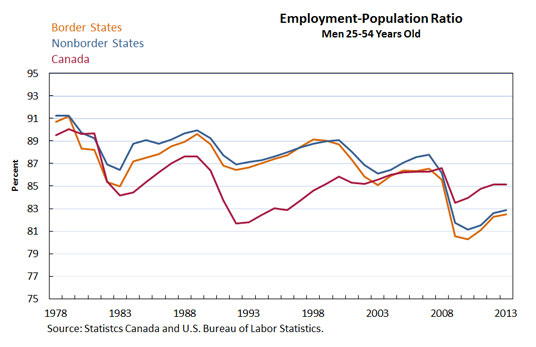A Comparison of American and Canadian Employment
U.S. employment remains depressed relative to where it stood prior to the recession of 2007-09. Some commentators suggest that no further recovery should be expected, arguing that current developments in the labor market are largely attributable to secular changes in demographics, such as an aging population.
If this view is correct, then one might reasonably expect Canadian and American employment rates to be roughly the same over long periods of time. This should especially be the case for U.S. states that share a border with Canada, as these states are the most similar to Canada in terms of their economic and demographic makeup.
The figure below plots the employment-to-population (working age) ratio for the U.S. and Canada. To control for factors related to secular changes in age and gender characteristics, we report the employment ratio only for “prime-age” males (ages 25-54). We divide the U.S. into two regions: border and nonborder states.1

The prime-age male employment ratio across both countries shows a modest secular decline over the sample period. The employment ratios in all regions averaged between 85 percent and 87 percent.
The cyclical behavior is quite different, with Canada experiencing a major recession in the early 1990s and the U.S. experiencing its major recession more recently. The Canadian prime-age male employment ratio is now at 85 percent, close to its historical norm. But the same is not true in the United States. In both border and nonborder states, the prime-age male employment ratio is less than 83 percent, far below its historical norm and significantly below its Canadian counterpart. The data presented here suggest that demographics are not the main driver behind the lackluster recovery in U.S. employment. The explanation is more likely to reside in economic policy and circumstances.
Notes and References
1 The border states in the U.S. are Washington, Montana, North Dakota, Minnesota, Wisconsin, Michigan, Ohio, New York, Vermont, New Hampshire and Maine.
Additional Resources
- On the Economy: How Important Have Employment Revisions Been the Past Two Years?
- On the Economy: The Rise and Fall of Labor Force Participation in the U.S.
- Regional Economist: Youth Unemployment Notably High in Southern Europe
Citation
David Andolfatto, ldquoA Comparison of American and Canadian Employment,rdquo St. Louis Fed On the Economy, May 12, 2014.
This blog offers commentary, analysis and data from our economists and experts. Views expressed are not necessarily those of the St. Louis Fed or Federal Reserve System.
Email Us
All other blog-related questions


